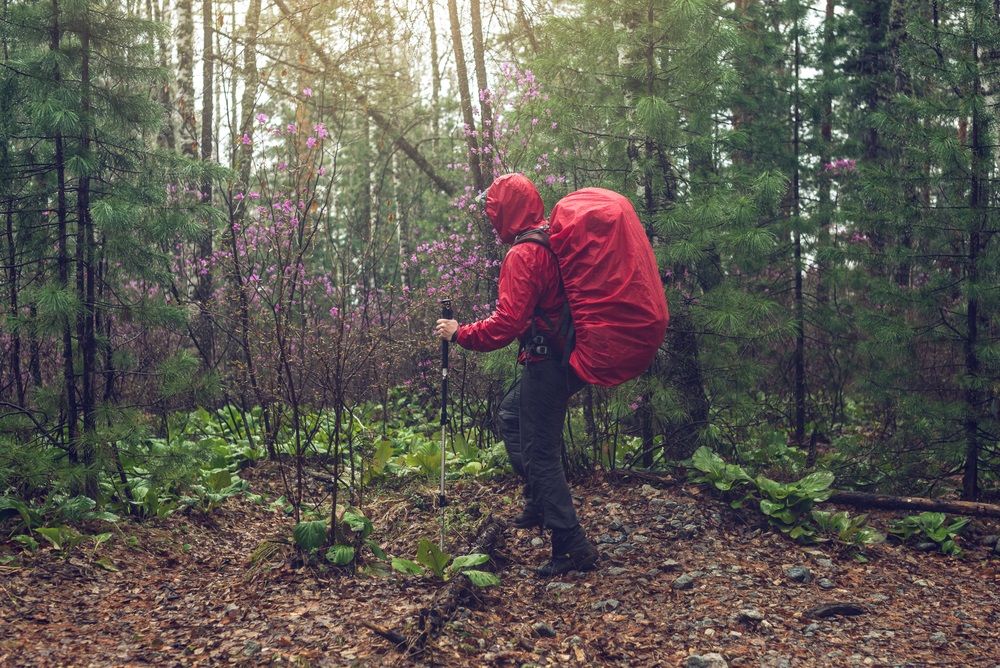
19 Aug 9 Tips for Hiking in Wet Weather
Rain has a bad reputation. Even though it’s just a bit of water falling out of the sky. And if you’re going to be in it, you might as well enjoy it. There are the puddles to jump in, the sound of raindrops bouncing off trees on their way down to earth and the fresh natural smells. The world is transformed when it rains – everything looks greener, the streams burble louder, the waterfalls gush and there’s the chance of a rainbow (or two)! No wonder children get such a kick out of playing in the rain. And if you manage to stay reasonably dry, a great advantage is that you’ll probably have the trails to yourself.
So, don’t be deterred when it rains, just be prepared. This is how you can do it;
-
CHECK THE WEATHER
Always check the forecast before setting out to make sure you’re not walking into a storm. This is a good habit to establish irrespective of the climate. And always keep an eye on the sky— if you notice lightning clouds forming in the distance, you’ll have some time to find shelter.
-
TAKE PLASTIC AND ZIPLOCK BAGS
A rain cover for your bag is important but it won’t keep out all the water, especially if you’re in the rain for long. This is a problem because a wet sleeping bag does not a happy camper make. The answer is to waterproof your bag by stuffing your clothes and sleeping bag into their own plastic bags and tying fastly. Dry bags can be used for keeping important equipment like cameras and phones dry inside your bag. Plastic shopping bags can also be used inside your socks to keep your foot dry in extremely wet conditions. Remember to open your pack as little as possible. Every time you open it or take the cover off, a bit more rain will get in. This wetness builds up and will probably stay with you for the rest of the trip.
-
DRESS ACCORDINGLY
They say there’s no such thing as bad weather, only inappropriate clothing. Whoever said that probably hasn’t seen a Cape winter. But they do have a point. There’s a fine balance between getting wet on the outside from rain and getting wet on the inside from sweat. Make sure your jacket is both waterproof and breathable and has zips for venting. You may also want to invest in waterproof breathable pants. Keep a warm layer like a fleece or synthetic puffy jacket in your pack to put on if you get cold. Whatever you do, avoid cotton clothing as it soaks up water and is not warm when wet.
-
SHOES
Waterproof trekking boots and waterproof gaiters (covers for your ankles and shoes) are great for short trips. They’re good at keeping rain out, as it seals off the gap between pants and boots. For longer trips, some people like to admit defeat and wear breathable trail runners. The thinking is that, on a multi-day rain trip, your feet will inevitably get wet. When that happens it can be better to just go with the comfiest option: trail-running shoes. Because they’re softer and more breathable than boots, they’ll minimize the potential blister damage otherwise caused by stiff leather and dry quickly in between rain showers. The other factor to consider is that when water gets stuck inside a waterproof shoe it creates its own set of problems as it can be quite difficult to get it out. Whatever you go with, be sure to pack extra pairs of dry socks.
-
FOOD
One of the great joys of hiking is all the food you can eat guilt-free along the way. Hiking in bad weather, however, forces you to eat on the move as you’ll get too cold if you stop for long periods in the rain. Bring quick snacks that you can eat on the go, such as energy bars and fruit. Try to avoid food that gets wet easily – no one likes a soggy sandwich!
-
BLISTERS
Wet socks will quickly rub the natural oils off your skin which leads to more water absorption, prune-like grossness and a much higher chance of blistering, especially in stiff boots. Make sure you pay extra attention to your feet during the hike and take plasters and blister creams with you.
-
MANAGING YOUR BODY
It may sound strange, but dehydration is an issue in rainy weather. People tend not to drink as much while hiking in the rain, but even on rainy days our bodies need about two litres of water to continue to function properly. Also keep an eye out for symptoms of hypothermia, and ensure you know how to treat it.
-
DITCH DESTINATION FEVER
Know your limitations. If a relentless storm makes things miserable or downright hazardous, turn around and call it a day. You’ll still have tales to tell and time for a hot shower and warm drink.
-
HAVE THE RIGHT ATTITUDE
When it comes to adverse weather, the ultimate tool you can have in your hiking kit is a good dose of perspective. Yes, the conditions are challenging, but moaning and complaining won’t improve them. Stay positive and just embrace it. Just think of the puddle jumping and rainbows and smells. Think of the adventure and stay positive.



No Comments